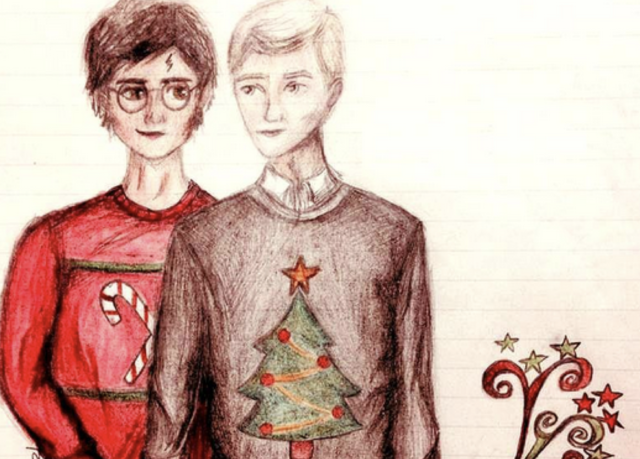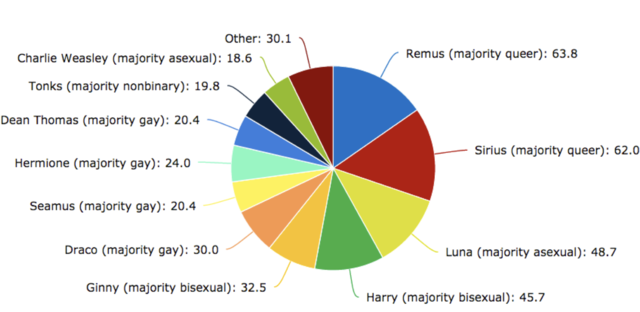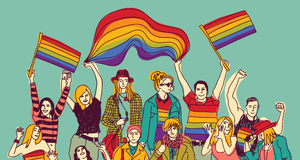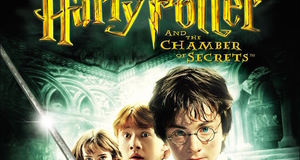Harry Potter is Gay: An Investigation of Queer Fan Culture
By
2017, Vol. 9 No. 03 | pg. 1/2 | »
KEYWORDS:
Not long after J.K. Rowling published the first Harry Potter book on June 26, 1997, The Boy Who Lived exploded into an international phenomenon. Teachers read Harry Potter and the Sorcerer’s Stone to wide-eyed students and parents read it aloud to put their children to sleep, continuing to turn the pages into the night. So many people wanted to escape to Harry’s magical world where nearly anything was possible – and these people began to respond to this universe in very real, critical ways. For some fans, like those at MuggleNet.com, that meant creating websites and publishing books containing theories of what might happen to sidekick Ron Weasley, for some it meant singing songs about whether Severus Snape is good or bad, and for others, it meant creating queer fan works. Queer1 fan works in response to the Harry Potter series come in a variety of forms: fan fiction, fan art, fan videos, fan theatre, fan activism, and fan music. I will mainly focus on fan fiction, since it is the most common form of queer fan reactions to Harry Potter. As both a fan of Harry Potter and a queer theorist, it is particularly fascinating to me that queer fan responses to this one book series have touched so many lives. Queer fan works impact queer readers’ experience with the Harry Potter books by creating a highly personalized world in which they are free to express themselves in a fashion that not only boosts their self-esteem as well as their representation in fan media, but also more deeply connects them to the text. In The Democratic Genre: Fan Fiction in a Literary Context, Sheenagh Pugh declares that fan fiction affects readers in a highly positive way. She states that our favorite stories can always be reworked into a modern setting: Pugh mentions that “reworkings” of texts can be traced to the likes of Chaucer: fifteenth-century poet Robert Henryson read Chaucer’s Troilus and Criseyde and was dissatisfied with Chaucer not describing what happened to Troilus in the end. Therefore, Henryson wrote his own sequel, The Testament of Cresseid. He uses Chaucer’s characters and others from Greek myth alike. Similarly, John Reed wrote an AU2 of George Orwell’s Animal Farm entitled “Snowball’s Chance” in which he explores what would happen if Snowball the pig returned to the farm and introduced capitalism. Textual reworking is also present in the Romeo/Tybalt3 fan fiction that Pugh mentions, entitled “Some Day” by author mintyfreshsocks, which is a take on Romeo and Juliet that’s more applicable to contemporary society: in this story, homophobia takes the place of old fashioned family feuds. I add that it takes not only great writing, but also great readers, for people of all backgrounds to feel compelled to respond to a text. Pugh refers to J.K. Rowling’s declaration that she reads fan fiction and that it flatters her, which encourages fan responses to her novels: here is an author that understands and is humbled by her readers’ need for their own interpretations of her magical universe, and by extension she acknowledges that her work and settings can continually be modernized. When we modernize stories, they become much more impactful on a generational level. With modernization comes the scrutiny of young people. People often claim that the younger generation is oversaturated with sex, and fan fiction does not escape these qualms. People often complain that fan fiction is overtly sexual, but Pugh asserts that it’s no different from the sexuality in anything else. She mentions that, for example, men’s collective interest in lesbians is taken for granted, so we should not think it weird or perverted when women – who make up the majority of fan fiction authors – take an interest in queer men. Likewise, in “Keeping Promises to Queer Children: Making Space (for Mary Sue) at Hogwarts,” Ika Willis writes about sexuality in fan fiction. She claims that writing slash4 is subversive, and quotes feminist scholar Eve Kosovsky Sedgwick arguing that it is important for children to know that the possibility of queer desires exists and is not immoral: “Writing fan fiction that makes room for queerness is making a textual world wider, brighter, bigger, in a way that has particular resonance with the predicament of young people” (163). Here Sedgwick and Willis argue that it is crucial for queer readers to experience being part of texts just as heterosexual readers do. Fan fiction’s inclusion of sexuality and sexual themes does not make it lesser than any other type of fan response to literature. Willis makes an intriguing, innovative claim when she comments on how the clue-filled, whodunit nature of the Harry Potter books encourages queer fan responses, writing, “The mystery structure of the books organizes the pattern of readerly activity and passivity around the term suspense: readers are to actively search out the books’ ambiguous signs and passively await the resolution which will retroactively determine how they will have had to be read” (159). She also argues that the Harry Potter books contain elements of Harry as a queer character – and for Willis this includes his highly charged relationship with Potions professor Severus Snape – but the only mention of homosexuality in the entire series is when Harry’s abusive cousin Dudley Dursley jokingly asks him if he has a boyfriend – showing that only a cruel person would propose Harry’s bonding with boys is in any way sexual. She mentions how up until Harry is fifteen he has only experienced sporadic desire for one girl – Cho Chang – and quotes a passage from Harry Potter and the Order of the Phoenix in which Harry describes his first kiss with Cho as “wet” and is frightened by it: “She was the one who started it… I wouldn’t’ve – she just sort of came at me… I didn’t know what to do.” Directly afterward, Hermione Granger’s suggestion that Harry and Cho spend time together “opened up a whole new vista of frightening possibilities. He tried to imagine… being alone with her for hours at a time… the thought made his stomach clench painfully” (406). For Willis, this is a moment where Harry comes off as nonheterosexual as he cannot even physically stand to think of his first kiss with his first crush. Willis claims that she is uncomfortable seeing this negative treatment of queerness in a text, but that it doesn’t stop her from creating queer fan works. She also states that writing fan fiction is not necessarily filling in gaps of missing text, but can instead be the insertion of a gap in the text. I think queer fan fiction necessarily creates and fills that gap. Willis concludes that fan fiction is a way of reorienting the source material that is an important act of resistance for fan fiction writers, readers, and consumers of other fan works to “scandalously act… as if it were natural to do so, as if all readings… were equally possible – as if there were not strong cultural prohibitions against… recognizing queerness in children’s fiction” (168). I agree with this notion as well as adding that because queerness is not negative or insulting, it should not be seen as more absurd than any other interpretation. Catherine Tosenberger would agree with Willis’s statement that Harry Potter is queer coded. In “Homosexuality at the Online Hogwarts: Harry Potter Slash Fanfiction,” Tosenberger writes, “Even more telling is Harry's destination: Hogwarts is a British boarding school, an institution that is so consistently coded as queer space that it's practically shorthand for homosexuality, British-style” (199). Tosenberger brings to the forefront the ways in which Harry Potter aligns itself with homosexual stereotypes; not necessarily negative ones, but typecasts that have endured and clued readers in for years: for example, some fans and scholars view Harry’s coming into the wizarding world as a coming out narrative. In addition, Tosenberger would agree with Willis and Sedgwick in regards to the notion that queer fan works create a gap in the Harry Potter books’ narrative, and that this gap can be filled with various, valid interpretations. Tosenberger asserts that Harry Potter slash comments upon the books themselves by speaking to the many available interpretations of the series. Tosenberger mentions that Draco Malfoy/Harry Potter was the first huge explosion of a Harry Potter ship5 with the rise of the Internet, and thereby the Harry Potter fandom, in the early 2000s. She addresses that adolescents’ sexualities are policed everywhere, but that with queer Harry Potter fan fiction they can easily express their own desires without fear or shame. Here, fans of all ages can express their sexual and gender identities without adult control. Tosenberger also points out that queer Harry Potter fan fiction will “provide an invaluable record of the creative responses of some of the series’ most dedicated and engaged readers” (203). I agree with Tosenberger’s point about leaving an invaluable record, and will expand upon this shortly by introducing a survey I created to gauge people’s reactions to, opinions about, and experience with queer Harry Potter fan fiction. I will now return to the premise of sexual themes, which are not the most prominent aspect of every fan fiction, but are noteworthy because of the reach of fan fiction and the wide scope of its varied, diverse audience. In “Pornography by Women for Women, with Love,” Joanna Russ discusses how we should be wary of the terms “art,” “pornography,” and “erotica” since not only are they manmade, but they are also moral distinctions. Where the word “erotica” is often used for women, “pornography” is usually designated for men, as if women are too polite to have an interest in others engaged in sexual activity. Furthermore, Russ claims that there is nothing wrong with people viewing sexual fan fiction as pornography, as “material presented outright as a sexual turn-on and nothing else can be a lot less harmful than material that is presented as if it were a thoughtful and complex depiction of real life” (90). Most people know they’re searching for porn when they select NC-17 or M as a rating on FanFiction.net; they don’t stumble across it by accident and assume that’s how all relationships should play out. Russ asserts that fan fiction is positive and cathartic because it aids women in figuring out their sexualities. Most people who write and consume fan fiction are women, and some feel insecure with themselves, which may be why hurt/comfort6 is so popular: it allows women writers and readers to imagine situations in which love prevails regardless of body image and other personal issues. Russ touches on how stories with a more sexual nature are less likely to be harmful or violent than G rated stories, which relates to the fact that sexual fan fictions are possibly less canon7 than G rated fan fiction. I’ll add that sexual fan fictions also tend to be less heartbreaking due to their noncompliance with canon. Russ also makes a great point about how the prevailing notion of women’s sexuality displays women being raped, tortured, and dominated, but writing fan fiction allows women to reclaim their sexualities, taking it into their own hands as an aspect of humanity that does not have to be inherently painful or negative. Furthermore, if a woman chooses to write fan fiction about dark themes such as rape, torture, or abuse, this can be another way to heal and take these situations into their own hands. Russ mentions that writers have to closely analyze texts to pull off good fan fiction, and this is true: the most popular fan fiction is often well written and in character. One exception is FanFiction.net user XXXbloodyrists666XXX’s “My Immortal,” a 44-chapter entity that quickly became the most popular Harry Potter fan fiction full of incorrect grammar and spelling, first uploaded in 2006. This fan fiction has its own Wiki page and has spawned a YouTube series, comics, spin off fan fiction, music8, a page of noteworthy quotes on the book rating site Goodreads.com, and cult-like group readings:
Another fan fiction that has become extremely popular – but contains a much more sophisticated writing style – is LiveJournal users dorkorific and ladyjaida’s twenty-six part Marauders era10 story “The Shoebox Project.” James Potter, Lily Evans, Peter Pettigrew, Sirius Black, and Remus Lupin are all main characters in this fan fiction, and after its pre-slash11, Remus and Sirius end up together. This fan fiction got so popular that fans who originally read “The Shoebox Project” as it was uploaded in 2004 to LiveJournal host an annual reread every December to celebrate the fan fiction. In addition, “The Shoebox Project” made it into the Wall Street Journal in which writer John Jurgensen discusses how author ladyjaida “has received e-mails from parents saying they read installments of the Shoebox Project aloud to their children indiscriminately alongside the Harry Potter books because it teaches lessons of tolerance” (Jurgensen). It is crucial, then, to promote queer fan works to younger people, especially when queer representation is scarce to begin with. Citing Kirk/Spock as the first gay ship stemming from Star Trek zines, Russ claims that the nature of fan fiction has always been self-pleasing, and I would like to strongly back this stance and add that this self-pleasure that fans get from reading fan fiction in which characters do not conform to norms of sexuality and gender should not be so readily accepted as a so-called “guilty pleasure,” but in fact, an acceptable and valid interest. In regard to authorial intent and authors’ opinions about fan fiction, Russ ties in Roland Barthes’ idea that the author is no longer relevant (69). This concept of “death of the author” makes sense with queer fan works in response to the Harry Potter books because queer fans will ship characters regardless of how the author feels about them doing so. Queer fans do not create fiction, art, and the like for the benefit of the author or the characters; it is for them and for fellow fans. Deidre Lynch’s “On Going Steady With Novels” is a discussion of different readers’ reactions to stories. She emphasizes that both critical readings and more emotional fan readings of texts are both valid. Lynch claims that, “We forget that linear reading is no more natural than any other ritual we perform with books” (216). I interpret this statement as being compatible with the fact that fan fiction is one of many ways of consuming our favorite texts. Lynch specifically refers to eighteenth-century novels and fictions, but her statements apply to the phenomenon of Harry Potter as well. Ultimately, Lynch argues that we return to the books we love and that we feel diverse reactions to stories: “Voluminous fictions also sponsor the comforts of continuation – of periodically picking up again where we left off, and of picking up again after we have left off” (216). Ika Willis’s statement about fan fiction offering fans different points of view about texts is relevant; she states that it is important to suggest to “fans new ways to engage with a reoriented canon” (153). After all, we write stories that are inspired by our own perception of life, and being totally objective about texts is wishful thinking at best – therefore, it is inspiring and refreshing to have new ways of looking at canon. Much of what these scholars have to say on the topic of queer Harry Potter fan works is echoed by non-scholars as well. Following up on Tosenberger’s point about leaving an invaluable record of creative fan responses, I sent out an online survey about queer Harry Potter fan works and garnered 166 responses. The most popular identity categories among survey respondents were 54.2% of respondents identifying as cisgender women12, 16.8% being sixteen years old, and 87% queer13. Most found out about fan fiction between ages 12 and 13 (40.3% of respondents) and the most popular way of discovering it was stumbling across it, most often through Google, other fan websites, and social media such as the blogging platform Tumblr. Many respondents also became invested in fan fiction and queer shipping through websites such as DeviantArt and LiveJournal, where images – such as the one of Draco Malfoy and Harry Potter below – drew them in. It is important to note that many were 12 or 13 when their interest in queer fan fiction began and are now adults (31% of respondents were in their 20s and cited being quite young when discovering queer fan fiction), because this demonstrates that queer narratives intrigue children and that they appeal to an ever-growing audience. In fact, Draco/Harry, or Drarry, was the second most popular ship that 28% of respondents reported reading and writing fan fictions about, with Remus Lupin/Sirius Black, commonly known as Wolfstar14, being the most common ship that 45% of respondents mentioned shipping. Drarry and Wolfstar are the two most popular queer ships in the Harry Potter fandom, and with good reason: the textual evidence for both relationships, if not for the characters being queer on their own – because you can read queerness into a character without shipping them – is overwhelming. I promote the assumption that singular characters are queer when I write wizard rock15, where large portions of my songs deal with queer themes, shipping related or not. Male-fronted bands The Whomping Willows and Justin Finch-Fletchley and the Sugar Quills perform songs in third-person such as “Draco and Harry” and “Dumbledore is Gay,” respectively, while my wizard rock songs are mainly from the point of view of queer people – most often queer women – and sometimes from my own point of view. Because queer representation is insufficient, I find it necessary to write from a queer woman’s point of view and openly acknowledge queer love songs: the first song I perform at concerts is usually “In Love With Lily” and I introduce it by saying, “This is about something that would have happened if I went to Hogwarts when Harry’s mom was there.” In announcing this, I let the audience know I’m queer and have no qualms singing lyrics about it such as, “I’m in love with her celery eyes / The way her hand feels in mine / When it brushes me accidentally / Making that feather levitate / I’m in love with you, Lily / Why do you tease me like this?” Through my music, I hope that others will be inspired to become comfortable with their identities and maybe even write their own queer fan works. While I write songs about characters regardless of any textual evidence that a character is queer or not, some fans pay a lot of attention to queer subtext. In “Homosexuality at the Online Hogwarts,” Tosenberger describes how Alfonso Cuarón, director of the Harry Potter and thePrisoner of Azkaban movie, interpreted Remus Lupin as a “gay junkie”and instructed actor David Thewlis to play him this way, which strengthened Remus/Sirius interpretations (Upton). Tosenberger describes the Remus/Sirius moments in the Prisoner of Azkaban movie:
These movie moments complement Wolfstar book moments such as what many respondents of my survey referred to as the “forty line stare,” which refers to a moment in Harry Potter and the Order of the Phoenix in which it is mentioned that Remus looks at Sirius and doesn’t noticeably take his eyes away for forty consecutive lines. Respondents also cited the fact that in the same book, Remus and Sirius give Harry a joint birthday present, and the fact that Remus and Sirius are respectively “rejected by one's family or by society” (dure-a-queer). Survey respondents cited Remus Lupin as the character with the highest rate of queer headcanons, with 63.8% of people viewing him as queer[16]. Ten of my survey respondents mentioned that Remus Lupin being a werewolf symbolizes his queerness. J.K. Rowling stated recently that, “Lupin’s condition of lycanthropy... was a metaphor for those illnesses that carry a stigma, like HIV and AIDS. All kinds of superstitions seem to surround blood-borne conditions, probably due to taboos surrounding blood itself.” Rowling’s statement ignores the fact that in 1981 when the CDC started to seriously document and notice some of the first cases of AIDS, people widely referred to it as “gay cancer” or “GRID,” an acronym for “gay-related immune deficiency” (Avert). One of my survey respondents specifically pointed out this harmful terminology regarding AIDS: “Rowling said that Remus' lycanthropy was a metaphor for aids, which used to be known as GRID… so I think it's a little ridiculous for him to be canonically straight. It feels like a cop-out” (Quinn F). This is not to say that every character with AIDS must be gay, as that move would be unfairly prejudiced, but there is an overwhelmingly popular tendency to erase the fact that gay men have always been subjected to this homophobic stigma and therefore intricately linked with it. Another Tumblr user who backed up their reasoning of believing that Remus Lupin is not a heterosexual character stated, “Rowling wanted lycanthropy to be a metaphor for AIDS, in a time where AIDS was still strongly connected with being a gay man. Even now, there is a vivid connection in most people's minds. Privileged people like to have metaphors for minorities, but they would work much better if the person was in that minority” (gonnagiveallmysecretsaway). This survey respondent sums up how representation for oppressed people is often so close but just out of reach. Furthermore, a vast majority of stories – fantasy and science fiction in particular – use supernatural creatures or choices forced upon characters as metaphors for oppressed identities. For example, Veronica Roth’s Divergent book series makes queer identities an allegory with its message of how we should not be forced to simply pick one type of personality to suit us. Some feel that this is adequate bisexual representation, and as we’re so used to these “are they or aren’t they?” plots, many – including several of my survey respondents – got a pleasant surprise when the new BBC series In The Flesh made bold statements in regards to being an outsider, being shunned by society, and war as well as literally having their zombie characters fighting a war, along with being canonically queer and mentally ill. This type of solid, concrete representation is invaluable and acts as a huge catalyst for drawing fans in: creators can no longer use the “it will make no money” excuse regarding queer characters. This brings me to my next point about queer baiting – which twenty of my survey respondents mentioned – that impacts consumers in a very similar way to queer metaphor characters and plots. Queer baiting is a more conscious effort on the writer’s part to interest a queer audience enough to get ratings and hold a retentive viewership or readership:
These writers are not dedicated to making their characters canonically queer, and subject queer consumers to painstakingly following their plot to watch for an official coming out moment that will never happen. Yearning for a character to be queer doesn’t always mean you want them to be queer just to be in a specific relationship with another character, as you don’t have to ship anything to desire queer representation. In fact, writers of shows like Supernatural and BBC Sherlock have their suspected-as-queer characters make queer jokes in the show, at one point saying something homoerotic and the next wondering how anyone could think they were queer. Several of these shows’ creators have stated that they realize some of their audiences wishes for certain characters to be queer, as seen in the tweet from a Supernatural creator above. Apparently, characters Dean and Castiel shouldn’t be in a relationship because they could simply be friends and have it be just as meaningful, which sounds legitimate until you take into account their queer themed banter: “[Castiel]’s not here. You see he has this weakness, he likes you,” “Cas, not for nothing,but the last time someone looked at me like that…I got laid,” and “You are not gonna die a virgin. Not on my watch.” In addition, one fan at a press conference attempted to thank Dean’s actor Jensen Ackles for his apparent portrayal of bisexuality, at which point he cut her off, said, “I’m going to pretend I don’t know what the question was,” and the event organizer escorted her back to her seat as the audience groaned in annoyance that a queer fan would dare to bring up such a touchy subject when it seems the show exists in part to laugh at queer people (The Scarlet Woman). This does an extreme disservice to queer fans, and would create a negative enough experience even without the fact that many of these fans pay to be made into jokes, as if our society doesn’t do that enough for them. Taking my survey results into account, it is also apparent that queer Harry Potter fan works have inspired many fans to grow as readers. Although one may be queer – like the majority of people who took my survey – they do not always spot problematic elements in texts. No one is free from society-instilled heteronormativity17, which engenders absolute fear of being different. Therefore, straight readers and queer readers alike must unlearn societal damage by learning to recognize heteronormativity for what it is: a toxic constraint on people’s sexual and gender identities. A majority of survey respondents claimed that reading queer fan fiction has altered their experiences as reader:
In fact, only 19 people, or 11.45% of respondents, said their experience as a reader has not changed, and seven of those people claimed it was another fandom that opened their minds:
From these responses, it is clear that queer fan works have an impact on the way people consume books, movies, and television. They have a heightened awareness of what the media sells. Many fans cited noticing queerbaiting more often, which comes with a cognizance that they deserve much more equal representation:
Here Danny’s statement echoes an important aspect of queer fan works, which is that often, people do not experience them alone. The queer fan fiction community unmistakably bonds members over representation of their identities:
Queer fan works have also helped many community members, such as myself, to come to terms with their own identities that they may not have seriously thought about beforehand:
In a culture where we do not often discuss varying sexual and gender identities, queer fan fiction is a priceless way for people of all ages to become invested in discovering who they really are. This is why it hurts many in the queer fan fiction community to hear others say their interpretations of their favorite characters are not legitimate, or that to write or draw out these interpretations somehow verges on blasphemy, is a low form of entertainment, or inappropriately sexualizes characters.Continued on Next Page » Suggested Reading from Inquiries Journal
Inquiries Journal provides undergraduate and graduate students around the world a platform for the wide dissemination of academic work over a range of core disciplines. Representing the work of students from hundreds of institutions around the globe, Inquiries Journal's large database of academic articles is completely free. Learn more | Blog | Submit Latest in Sociology |




















